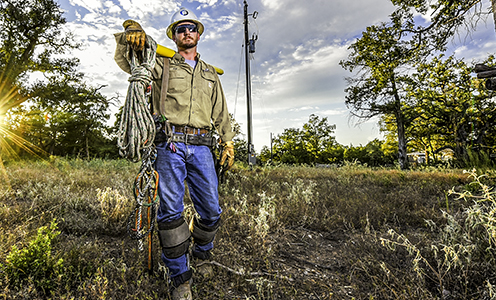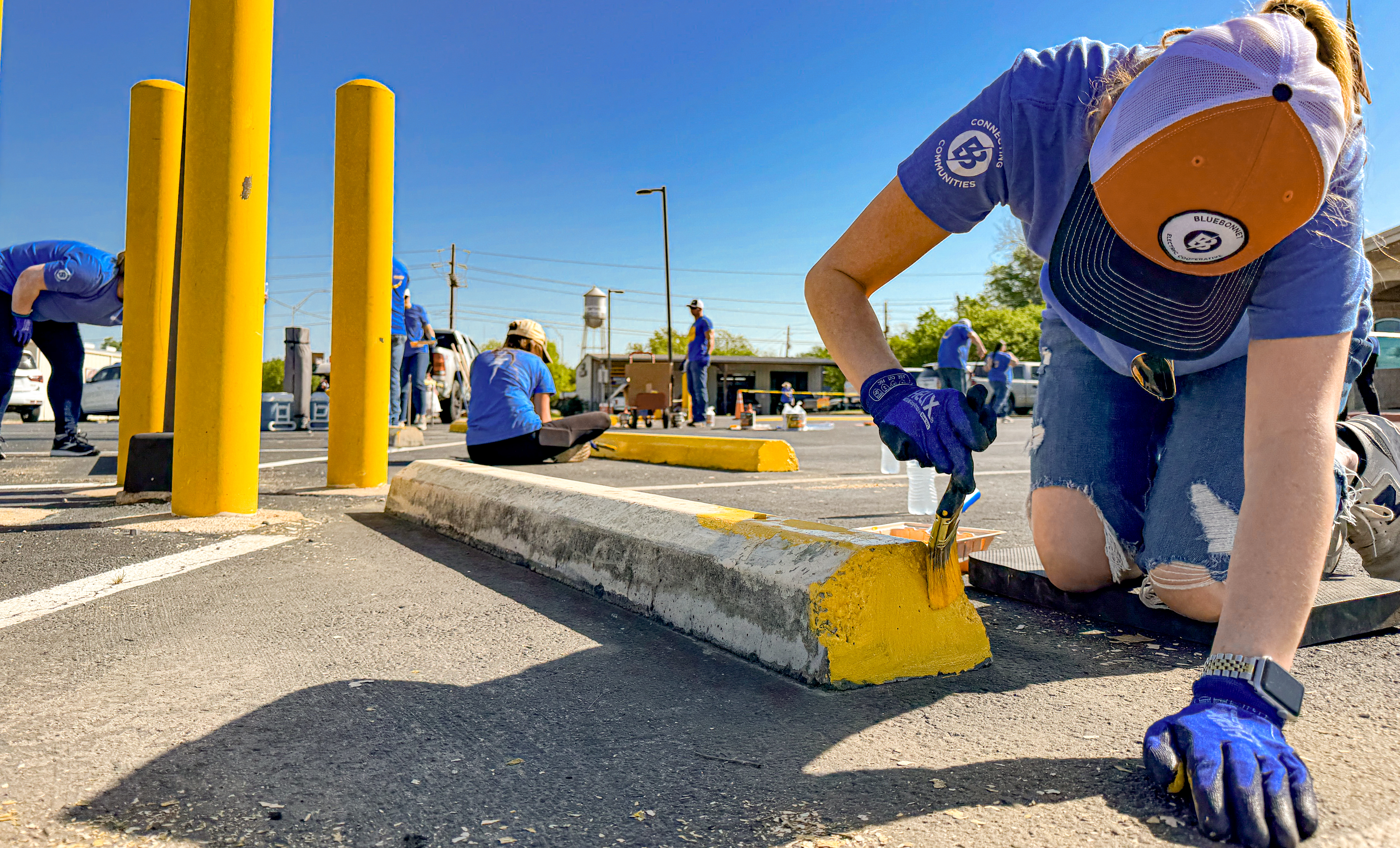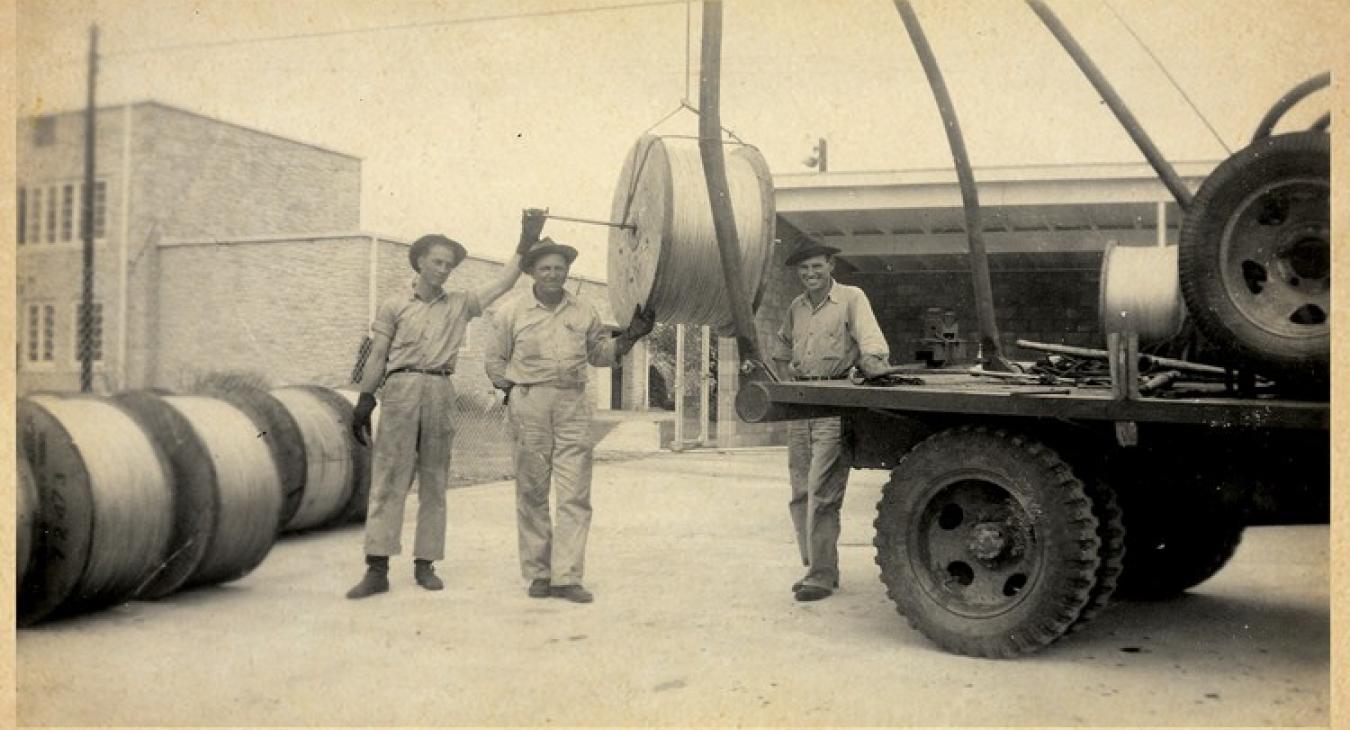Bluebonnet line workers in the 1940s take a break from their hazardous and backbreaking work in Giddings, original home to the co-op’s headquarters. From left, William Proske, Walter Urban and Winslow Zwerneman.
By Clayton Stromberger and Denise Gamino
If you were born at least fourscore and seven or so years ago, and grew up in these parts, you may remember what it was like in 1939.
No one was in a huge rush back then. The highway speed limit was 45 mph — lower for trucks. More than half the state was rural. Kids in the country rode a horse to confirmation class. Air conditioning meant opening a window or sitting on the front porch with a hand-held fan from church. Screen time was for when the mosquitoes came back.
To communicate with faraway friends and family, you wrote long letters by hand and carefully saved the letters you received. To make a telephone call, you usually had to go through a switchboard operator — someone like German-born Selma “Grandma” Schwartz in Burton, who’d been on the job 29 years in her big wooden swivel chair and kept all the party lines straight with constant plugging and unplugging of cords and jacks. Folks read the local weekly newspaper page by page, and each issue had a section to keep you updated on the important comings and goings around town (“Miss Martha Woodson, of Texas University, Austin, was home last week-end.” “Eben Price, of Waco, was a business visitor here Tuesday of this week.”)
Somehow everyone survived without Twitter and cell phones.
At the country store, or the town café, people would stand or sit around and talk with neighbors and strangers about the weather or politics or how the Aggies were doing — and they were doing well, working their way to a 20-0 Thanksgiving Day drubbing of the Longhorns and, by season’s end, the national title. On the radio, if you could afford one, you might listen to Jack Benny or Bob Wills or perhaps Fred Waring and his orchestra; everyone would gather around when it was time for one of President Franklin D. Roosevelt’s “fireside chats.”
Kids buying comics at the town drugstore had new favorite characters to follow — Batman premiered in “Detective Comics” in May and “Superman No. 1” appeared in June.
The Great Depression, which had begun with the stock market crash a decade earlier, was slowly beginning to ebb and recede, and folks finally started to have a bit of pocket money. The minimum wage rose a nickel to 30 cents. Yams were two cents a pound at Dippel’s Food Store in Caldwell; a 28-ounce jar of Pure Apple Butter was 17 cents. When going into town, men wore hats and often a jacket and tie. Women wore hats, too, and dresses — nothing too fancy, and sometimes made at home, but they were part of what was considered proper attire for Main Street in the communities within the Bluebonnet service area. There was a lively bustle on weekdays and often on Saturdays as well. And it was a treat on a Friday night to see a movie at the Strand in Bastrop, the Sterling in Giddings or the Baker in Lockhart (showing the first week of January, 1939: “The Dawn Patrol” with Errol Flynn).
The theaters were segregated, as were the schools, the water fountains and lunch counters. Slavery and the Civil War were still in the living memory of the area’s oldest residents. Lifelong Travis County resident John Crawford, who was 81 in 1939, could still tell a visitor about his early days as a slave on a plantation in Manor. He was a child when word came of the Emancipation Proclamation of 1863, but back in 1939, he had detailed memories of the day more than seven decades earlier.
In 1939, shiny new automobiles enticed passers-by at small downtown dealerships or glided by with their large graceful curves and Art Deco grilles. They made the occasional surviving beat-up Model A look like a raggedy scarecrow in comparison. The new model Chevy pickups were touted in ads as “big, brawny,” with improved “Supremline styling” and front windows you could crank open.
While filling up at Arbuckle Oil in Elgin, you might pull up alongside one of everyone’s favorite vehicles — the Blue Bell Creameries delivery truck, a refrigerated 1933 Chevy model that chugged up and down the country roads to deliver 5-gallon cans of “B.B. Ice Cream” to Lotta Cream counters in drugstores across the area. Lotta Cream booths — created in 1935 by Blue Bell General Manager E.F. Kruse to sell scoops inside local establishments — were your places to go for relief on a broiling summer weekend, all for a nickel a cone. On a typical Saturday in August, customers at the Lotta Cream #1 inside Mr. Schmid’s Savitall grocery store in Brenham consumed 110 gallons.
Life moved at a calm pace, but changes were just around the corner. In parts of Central Texas where the night had long been lit only with moon glow, candles and kerosene lamps, electricity was coming. The Lower Colorado River Electric Cooperative (later renamed Bluebonnet Electric Cooperative) received a state charter to provide electricity to residents east of Austin in Washington, Fayette, Austin, Lee, Bastrop, Travis, Williamson, Caldwell, Hays and Guadalupe counties, thanks to the relentless work of a young Texas congressman — and future U.S. president — named Lyndon Baines Johnson. (Later, parts of Burleson, Colorado, Gonzales and Milam counties were added to the Bluebonnet service area.)
In rural Fayette County, Isabel Albrecht saved up and bought a washing machine when the electric grid finally reached her cotton farm in Willow Springs, 22 miles east of La Grange. That’s where she and husband Oscar also raised cattle and chickens. But even after home electricity, she still preferred to scrub clothes on a washboard.
War was coming, too, though that was still just a rumble in the distance. In July, an article in Life magazine asked a group of prominent journalists just returning from Europe, “Will there be war?” No, reassured Amon Carter of the Fort Worth Star-Telegram, and his colleagues agreed. But in September, as Fred Quitta (seen in the photo at right, top row, fifth from the left) and Edward “Toad” Smith (third row, second from left) suited up for their Smithville Junior High Tigers football game, German tanks were already rolling into Poland. Five years later, those two young men would join the heartbreaking list of those who had given their lives in the defense of freedom. Quitta died in the battle to take the island of Leyte in the Philippines from the Japanese, and Smith lost his life at Saint-Georges-d’Elle, France, just three weeks after D-Day. Tiger teammate Carl “Rusty” DeLoach (top row, fourth from right) served on the destroyer USS Black, survived the war, and returned to Smithville to work on the railroad and marry his high school sweetheart Juanita. DeLoach died in 2013 at age 86; Juanita, who had been by his side for 65 years, died 12 hours later in her sleep.
The Great War, known then as “the war to end all wars,” had started just 25 years earlier, and some of its veterans living in Central Texas were still in their early 40s. In fact, that terrible conflagration received a new name in June of 1939, when Time magazine grimly dubbed it “World War I” with a gloomy eye to “World War II” building in Europe.
Other changes, as a tumultuous decade entered its final year: On Jan. 17, radio host and flour mill owner W. Lee “Pappy” O’Daniel was sworn in as the state’s 34th governor with great hoopla at Memorial Stadium in Austin with 37 marching bands and an attendance of 60,000. O’Daniel replaced James V. Allred, who late in his second term was nominated by President Roosevelt to a federal district judgeship.
In Giddings, a new mural was unveiled on the wall of the U.S. Post Office. The artist hired by a federal New Deal jobs program had painted cowboys opening mail at a rural mailbox, including one who received a package of red cowboy boots. The painting shows mountains in flat Lee County, but the postmaster called the mural “a first class job.” New Deal post office murals were also completed in 1939 in Elgin, Lockhart, Smithville, La Grange and Caldwell. In Lockhart, the young men of the Civilian Conservation Corps were busy building a swimming pool next to Clear Fork Creek that later would become part of Lockhart State Park. Additional New Deal workers were building Bastrop State Park and Buescher State Park near Smithville.
These moments and so many others live on in the black-and-white photos taken that year by photographers such as F.C. Winkelmann in Brenham and Harry Forrest Annas in Lockhart, who each had downtown studios for decades in their communities. They documented countless weddings, babies, funerals, group photos and civic events both grand and intimate. We are fortunate to have their images as we look back and wonder what life was like then.
Although the people in these hand-printed black-and-white images are frozen in time today, they lived these moments in color. For them, the days of 1939 slipped by one at a time, a bit quicker than folks wanted them to.
What was to come was uncertain. They didn’t know how the story would end, but their contributions live on in this particular patch of Texas that stretches from the San Marcos River in the west to the Brazos in the east.
Download this story as it appeared in Texas Co-op Power magazine »





